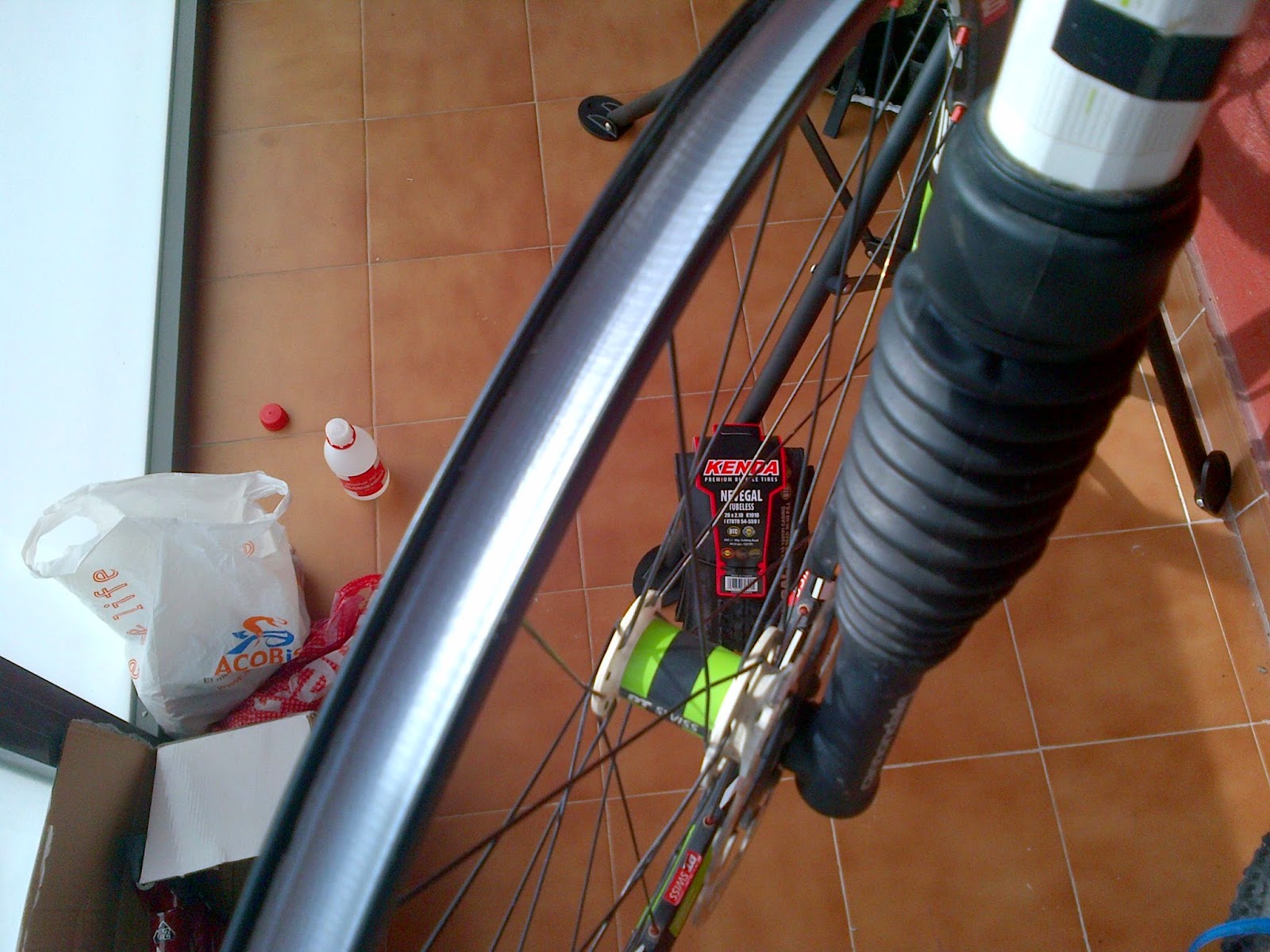Comenzamos aquí la sección de bricolaje y de DIY de La Cabra Tira al Monte tubelizando una rueda que iba montada con cámara y fondo de llanta estándar, con varias ilustraciones de como debe hacerse.
Ingredientes:
- 1 rueda (preferiblemente tubeless, en mi caso una DT Swiss XCR 1.5).
- 1 cubierta (preferiblemente tubeless, en mi caso una Kenda Nevegal).
- Cinta americana (que sea buena, osea, impermeable, con trama y que pegue bien, en mi caso he elegido una en el típico color gris de la marca Pattex).
- 1 válvula tubeless con obús desmontable.
- 1 llave desmonta obuses.
- Líquido sellante (después de probar infructuosamente mis dotes de alquimista fabricando mi propio líquido casero, tarde unos meses en darme que cuenta que era una pérdida de tiempo y un sellado que no sellaba; ahora confío plenamente en el Stan´s No Tubes que me recomendó mi amigo Juan, y que realmente es increíble como tapona las rajitas y los pinchazos).
- 1 jeringuilla sin aguja.
- 1 metro o calibre para medir la anchura de la llanta.
- 1 cuchillo que corte bien.
- Bridas.
- Alcohol.
- 1 trapo.
- 1 bomba de taller.
- Agua.
- Jabón.
- Tiempo, paciencia y sobre todo ganas de hacerlo.
Como veis, no se necesita apenas nada para olvidarse del mundo del pinchazo, del parche y de la cámara e introducirse en el maravillo mundo del tubeless.
Pasos:
Lo primero que hay que hacer es desmontar la antigua cubierta, quitar la cámara y el fondo de llanta. Con la llanta al descubierto, procedemos a limpiarla por dentro (y ya que estamos por fuera) minuciosamente para que no quede rastro de suciedad.
Del esmero de la limpieza, dependerá directamente el éxito de nuestra tubelización, así que merece la pena dejar la llanta inmaculada tanto en sus fondos como en sus laterales.
Una vez limpia, medimos con un calibre o regla el interior de la llanta para saber el ancho de nuestro nuevo fondo de llanta casero adhesivo e impermeable.
Ahora tendremos que cortar la cinta americana a medida. Yo le he dado 1,5 mm más, ya que al estirar al pegar, se estrecha un pelín. (*BRICOTRUCO: Para cortar, mido la cinta y pongo unas bridas en la distancia deseada que me servirán para cortar recta la cinta con el cuchillo).
Con la cinta cortada a la medida, empezamos a pegarla con sumo cuidado en la llanta con el objetivo de tapar los agujeros de las cabezas de los radios para que no se escape el aire por ahí.
Yo le doy 2 vueltas completas a la rueda, empezando unos 2-3 radios antes del agujero de la válvula y terminando 2-3 radios después; es decir, en la válvula, llevará 3 capas de cinta y en el resto de la llanta 2.
Una vez terminado el precintado, con el mismo cuchillo que he cortado la cinta, hago una pequeña cruz (pequeña), por la que introduciré la válvula tubeless. Importante lo de "pequeña cruz", porque si la haces grande... el aire se escapará por ahí... una obviedad.... pero que por un descuido te puedes cargar todo el trabajo anterior.
Este sería el resultado con la válvula ya metida y el fondo de llanta colocado. Sólo nos quedará montar la cubierta, enjabonar con agua y jabón los flancos de la misma para que deslicen y encajen perfectamente con la uña de la llanta. Ahora ya, con mucho ritmo, fuerza, una buena bomba, y mucha coña y/o suerte divina, talonaréis la cubierta a la primera y podréis hincharla como yo.
Importantísimo si no queréis morir de un infarto!!!, es no exceder la presión máxima de la cubierta para que no explote. Me ha pasado en más de una ocasión y aún tiemblo del susto sólo de recordar la explosión. Explotar no es un modo de hablar, es una explosión pero de verdad.
Conforme hinchéis, se oye "clac" "clac" "clac" al ajustarse y meterse la cubierta en los flancos de la llanta. Si está bien lubricada con agua y jabón, se coloca bien. Yo para ésta, sólo he subido a 3,5 BAR. En la foto casi se aprecia como burbujea el jabón en los flancos al salir el aire al ir talonando.
Una vez ha talonado la cubierta, es el momento de introducir el líquido mágico y olvidarse de los pinchazos para siempre, (o al menos hasta que se seque el líquido o rajes la cubierta... jejeje).
Para ello se desinfla la cubierta con cuidado tratando de no destalonarla. Se desatornilla el obús y con una jeringuilla se introduce el líquido. Yo como estrenaba cubierta y fondo de llanta, he echado 70 ml para que selle todo bien, las posibles fugas en los flancos, en la válvula o hipotéticos poros.
Con el líquido dentro, montamos obús, volvemos a rezar para hinchar con la bomba de taller sin tener que recurrir a un compresor y evitar darnos un paseo hasta la gasolinera más cercana, y dejaremos la rueda con una presión alta, rondando el máximo permitido (repito: nunca pasarlo por grandísimo riesgo de explosión), para que selle todo bien.
Se pretende con una presión alta que el aire trate de escapar de la cubierta y el líquido sellante haga su función. Durante las primera 24 horas yo dejo la rueda hinchada a presión alta y de vez en cuando le doy unas vueltas y giros para distribuir el líquido por toda la superficie interior.
Cuando queráis salir a montar... es cuestión de comprobar que ha quedado todo sellado y bajar la presión a vuestros gustos y necesidades. Yo con unos 80 kg suelo ir en tubeless a unos 2,25 BAR aproximadamente, esto es, en el límite inferior recomendado por el fabricante.
Espero que os haya gustado este tutorial amiguitos!!!
Os doy abrazos y os deseo muchas rutas sin pinchazos para todos!!! ;-)










